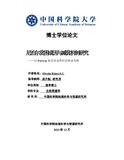Please use this identifier to cite or link to this item:
http://archive.nnl.gov.np:8080/handle/123456789/336| Title: | Mechanism of Poverty Formation and Poverty Alleviation in Nepal (A case study from agriculture and community forestry of Bajhang district) |
| Authors: | G.C., Dhruba Bijaya |
| Keywords: | Poverty Reduction, Pro-poor, Multidimensional Poverty, Bajhang district, climate change, lack of resources |
| Issue Date: | 25-Mar-2019 |
| Abstract: | Poverty is a common phenomenon in developing countries like Asia and Africa. Nepal is one of the poorest countries in South-Asia. Although, poverty alleviation has been one of the top priorities for the national development since 1976, but still poverty is widespread, persistent and also an acute problem in Nepal, where people are in a state of deprivation with regard to incomes, clothing, housing, healthcare, education, sanitary facilities and human rights. Eradicating extreme poverty and hunger is the first and main objective of the Millennium Development Goals (MDGs). Halving the poverty into half by 2015 is the main agenda of UN. Poverty is concentrated in the remote village, uplands and mountains, the landless, dalits (or Scheduled Castes) and small and marginal farmers. The revised poverty line of $1.25 a day is used as a bench mark to conduct this research. Till now, there remains little understanding about the actual field situation of poverty in the context of Nepal. This is a study about Nepal, where agriculture and forestry is taken as a case. The goal of this study is to analyze the overall poverty situation of Nepal. And Bajhang district was chosen as a case study site, which is one of the poorest and remotest districts of the country. Here the data about poverty characteristics, mechanization, formation and distribution in different rural settings have collected through extensive fieldwork in order to get the first-hand research data. It is hoped to provide a scientific basis for the development and management decision-making of local government to develop the programs which will help to reduce the poverty in those areas. To achieve the above research goals, different Participatory Rural Appraisal (PRA) and Rapid Rural Appraisal (RRA) tools including secondary data were used to gather information. A well-structured household survey, focus group discussion and semi-structured interviewed were conducted in Bajhang in 2013, and totally 300 samples were collected. This paper first gives a macro analysis of Nepal’s poverty situation, and then analyzes the mechanization, formation and distribution of poverty in the study area empirically. Secondly it focuses on multidimensional poverty which is a new idea about studying poverty. The third part studies the environmental effects on poverty systematically, taking climate change and its effects on the rural poverty. Finally, it deals with the framework that can be used for reducing poverty in Nepal. |
| URI: | http://103.69.125.248:8080/xmlui/handle/123456789/336 |
| Appears in Collections: | 500 Natural sciences and mathematics |
Files in This Item:
| File | Description | Size | Format | |
|---|---|---|---|---|
| Final Thesis 2015.12.01.pdf | 4.43 MB | Adobe PDF |  View/Open |
Items in DSpace are protected by copyright, with all rights reserved, unless otherwise indicated.